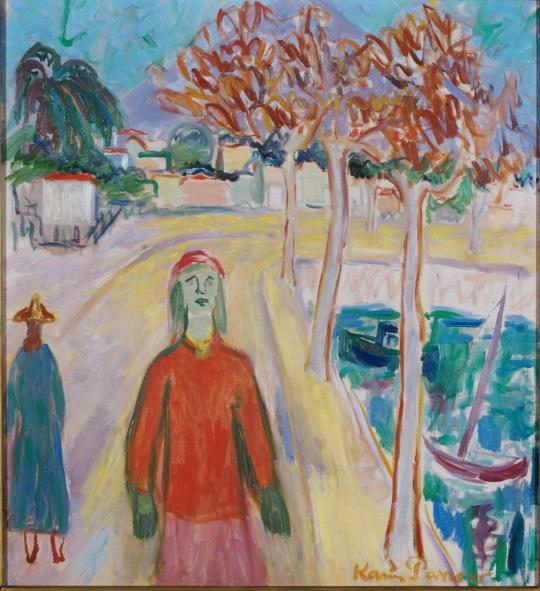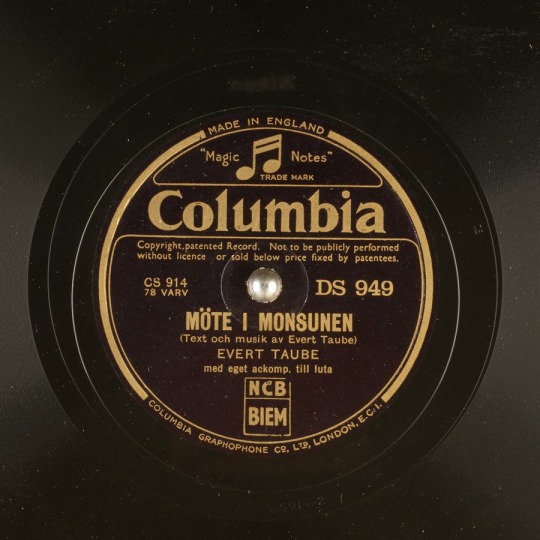#Evert Taube
Explore tagged Tumblr posts
Text

Karin Parrow (March 4, 1900 - 1984) was a Swedish painter and part of Göteborgskoloristerna. She was one of 13 kids - her big brother being the famous troubadour Evert Taube. Like him she was quite adventurous, and during her studies in Paris at the Académie de la Grande Chaumière in 1929, she married a sea captain and set off.
Her art consists of colorful and playful landscapes, still lives and portraits, and it hangs at most major Swedish museums.
Above: Badande kvinnor, no year - oil on canvas (Bohusläns museum)
#art#swedish artist#karin parrow#evert taube#göteborgskoloristerna#académie de la grande chaumière#bohusläns museum#oil on canvas#beach scene#bathing women
7 notes
·
View notes
Text


Staty av Evert Taube
#lensblr#imiging#canon eos 600d#photographers on tumblr#original photographers#goteborg#evert taube#sea
2 notes
·
View notes
Text
youtube
1 note
·
View note
Text




Fun fact: In 2019 Joakim Thåström was awarded the Stockholm City Bellman-prize. This was actually the second time he was awarded said prize. The first time, in 1991, he refused the honour saying it felt wrong accepting money from politicians when you've spent a career in music mocking those in power.
Thåström: "Carl Michael Bellman was a rebel. Evert Taube was a rebel"
Per Hägglund: "Evert was for god's sake [inaudible] for several...
Christian Falk: "Bellman was a rebel prostitute..."
Thåström: "They're both from Söder in Stockholm anyway..."
Christian Falk: "...at the royal court!"
Thåström: "...or atleast they lived at Söder in Stockholm. I can inform you that Bellman was born on the same block where I live!"[x]
2 notes
·
View notes
Text
Found out today, in a rude and icky way, that my name means cock (yes, as in dick, pecker or prick) in Albanian. If you count that, I guess it's a lot. Otherwise, I can only think of Här är den sköna sommaren by Evert Taube.
well now im curious
10K notes
·
View notes
Text










I found this book. Vaggvisor is swedish for lullabies🩷 I often called Thomas magpie; they feel like me, him and Lullaby❤️ I haven’t heard ’När månen vandrar på fästet blå’ before but the moon is a symbol for Lullaby❤️ I often called her my little owl; special that is the picture with ’Videvisan’ by Alice Tegnér❤️ I haven’t heard ’Himlen är av stjärnor full’ either; star is for Rockstar & the bears feels like me and Thomas💞 ’Byssan Lull’ by Evert Taube was always special for me.
1 note
·
View note
Text
Now lovely welcome Evert Taube...Hedningarna... and Metallica...songs are released 🥰 https://youtube.com/@herrmusicentertainer?si=cy3qALQ1fuPvV8fM
1 note
·
View note
Text
11 novembre … ricordiamo …
11 novembre … ricordiamo … #semprevivineiricordi #nomidaricordare #personaggiimportanti #perfettamentechic
2022: Sven-Bertil Taube, Sven-Bertil Gunnar Evert Taube, attore e cantante svedese. Figlio del cantautore svedese Evert Taube e della scultrice Astri Bergman Taube, Sven-Bertil iniziò ad appassionarsi alla musica folk e al folklore in generale viaggiando per l’Europa ancora molto giovane, tenendo concerti quand’era ancora soltanto uno studente della Royal Beskow School di Stoccolma. aube lavorò a…

View On WordPress
#11 novembre#Andrea Palma#Anna Menzio#Ave Maria Ninchi#Ave Ninchi#Charles Jacqueau#Dina Gralla#Dina Sventen#Eugenia Benbow Sheppard#Eugenia Sheppard#Francois Charles Jacqueau#Guadalupe Bracho Pérez-Gavilán#Isa Bluette#John Aniston#John Anthony Aniston#John Charles Andes#Keith Andes#Morti 11 novembre#Rayford Barnes#Robert Francis Vaughn#Robert Vaughn#Sven-Bertil Gunnar Evert Taube#Sven-Bertil Taube#Teresa Ferrero#Wanda Osiris#Yannis Anastassakis
0 notes
Text
It often reminds me of the Swedish shanty(?) Balladen om Briggen 'Blue Bird' av Hull by Evert Taube, in which the titular ship (Blue Bird) is caught in a storm off the coast of Sweden. The swede, Karl Stranne, is tied to the helm, since he is a capable steersman and familiar with the waters. But it soon becomes obvious that they won't make it, and signal for help, Karl Stranne knowing that his father will come to their aid. The crew abandon ship and make it to shore, and Stranne Sr. pours out shots for the crew inside. He asks for the name of the ship, and when the Captain answers "Blue Bird of Hull", Stranne Sr exclaims "Blue Bird of Hull? God in heaven, but then where is my son?" The Captain pales, as he remembers "Karl was tied to the helm and forgotten aboard."
It's apparently based on a few similar incidents at sea.
Honestly, the Captain tied to the wheel with cross in hand is probably the most striking image in the book, and frankly, one of the most striking images in horror fiction generally. A master stroke on Stoker’s part.
1K notes
·
View notes
Text
B:sides ~ Evert Taube ⛵️💃🇸🇪 2021
Musik af de 10 som erhållit Taubestipendiet från SKAP 2021
SKAP https://www.skap.se/2021/06/23/10-taubestipendier/
Lira https://www.lira.se/payam-tabatabayi-en-av-hela-tio-nya-taubestipendiater/
Päyam Tabatabayi
youtube
1 note
·
View note
Photo

Karin Parrow (March 4, 1900 - 1984) was a Swedish painter and part of Göteborgskoloristerna. She was one of 13 kids - her big brother being the famous troubadour Evert Taube. Like him she was quite adventurous, and during her studies in Paris at the Académie de la Grande Chaumière in 1929, she married a sea captain and set off.
Her art consists of colorful and playful landscapes, still lives and portraits, and it hangs at most major Swedish museums.
Above: Kvinna i allén, 1945-48 - oil on canvas (Moderna Museet)
#art#swedish artist#karin parrow#1940s#göteborgskoloristerna#moderna museet#oil on canvas#figure in landscape#académie de la grande chaumière#evert taube
8 notes
·
View notes
Text
Kalla den änglamarken eller himlajorden om du vill.. jorden vi ärvde och lunden den gröna.. vildrosor och blåklockor och lindblommor och kamomill.. låt dem få leva, de är ju så sköna
-Evert Taube
Call it angel's field or heaven's soil.. we inherited the earth and the green, lush grove.. wild roses and bellflowers and linden flowers and chamomile.. let them live, they are oh so fair
16/5-20
2 notes
·
View notes
Text
Thanks for offering! The use of this word has confused me for years. Lille Roland is from Vänner och Fränder:
Dig vill vi giva en kungason till man Som haver mera guld än lille Roland haver land
A young girl is supposed to marry a prince because he's richer, but she ends up eloping with lille Roland instead.
Och Jungfrun hon lägger sig vid lille Rolands sida Hon känner sig varken sorgsen eller kvida
So from context it seems that his poverty is important here. But when it comes to women it's more mysterious.
Liten Kerstin plays the main role in this... kinda strange ballad. But she's also in other songs and usually as a girl from a humble background who has some kind of romance with a nobleman. Apparently this was based on a true story of a woman who rose socially and became a motif in folk ballads. But I forgot the details. I read/played a lot of Swedish folk songs when I was sick all winter 6 years ago and there were a lot about Liten Kerstin, but I can't easily find the lyrics online.
Herr Peder och liten Kerstin de sutto över bord den älskog vilje vi begynna De talte så många skämtsamma ord. Allrakärasten min, jag kan eder aldrig förglömma.
From what I've seen, it usually ends badly. Them rich folk can't be trusted. Though it seems she has money here, judging by the clothes she gets made.
But Hilla Lilla, from the song by the same name, definitely doesn't come from a humble background. Thanks to her caring father, she had a knight as a personal servant. After eloping with him and getting caught, she was sold away. So I guess she's poor now. She works for a queen. But I suppose the queen's other servants aren't much richer either, so idk why the song should draw attention to her poverty in particular.
Hilla Lilla sitter i kammaren sin Ingen vet min sorg utan Gud Hon fäller så mången tår uppå kind Den lever aldrig till som jag kan klaga mina sorger
And, to complete my confusion, there's a modern song by Evert Taube called Dansen på Sunnanö, which features a "lilla Eva" and I can't really imagine that her economic situation has any effect on the story. If anything, it would make sense for the song to draw attention to her being young instead since the song is all about youth and the loss thereof.
Där går en dans på Sunnanö, där dansar Rönnerdahl Med lilla Eva Liljebäck på pensionatets bal
Och lilla Evas arm är rund och fräknig hennes hy Och röd som smultron hennes mun och klänningen är ny
She dances with the aging gentleman Rönnerdahl first and makes some cheeky remarks about his past conquests, then dances more passionately with the young cadet Rosenberg later:
Och lilla Eva dansar ut med fänrik Rosenberg Och inga fräknar syns på hyn, så röd är hennes färg
I guess it's possible that she's a little girl, but based on what she says and how she's described, I think she's a young adult. So how is she lilla..?
Is it possible that some Swedes aren't aware that the -e ending after adjectives ('den gamle mannen') is masculine and think that it's an 'old-timey way to end an adjective'? I know it's been falling out of usage a bit, so it can seem like 'just old'. I've seen folk bands use it for words that aren't grammatically masculine at all. Or is there a different reason for that? I've even seen it used for a woman.
25 notes
·
View notes
Text

Evert Taube is Sweden's much loved balladeer who is so popular that there is not one but three statues of him in the City of Stockholm. This one is right across the water from the Stockholm City Hall building.
#stockholm#sweden#photographers on tumblr#photography#my photos#sverige#urbanphotography#urbanphotoshoot#original photographers#original post#evert taube#city hall#stockholm city hall
30 notes
·
View notes
Video
2008 Baltic Holiday Sweden, Stockholm by Tony Via Flickr: A Statue of Evert Taube. He was an author composer and singer. A very endearing and life like statue in Stockholm.
#Holiday#Journey#Baltic#east sea#car#camper#road#europe#Sweden#Stockholm#Bredang#Mälaren#lake#shore#water#Evert Taube#statue
25 notes
·
View notes
Text
Evert Taube - Möte I Monsunen
Evert Taube – Möte I Monsunen
Evert Taube – Möte I Monsunen mp3 download, lyrics. Stream and download this Amazing music Evert Taube – Möte I Monsunen mp3 download, lyrics, instrumental, Video now available for streaming and download at korrectvibes. So make sure you download the music and share with your friends. If you’re a music lover, the song is A nice track that should be on your music library. Evert Taube – Möte I…

View On WordPress
0 notes